Close Eye on Compliance as Historic ʻĪao Release is Planned
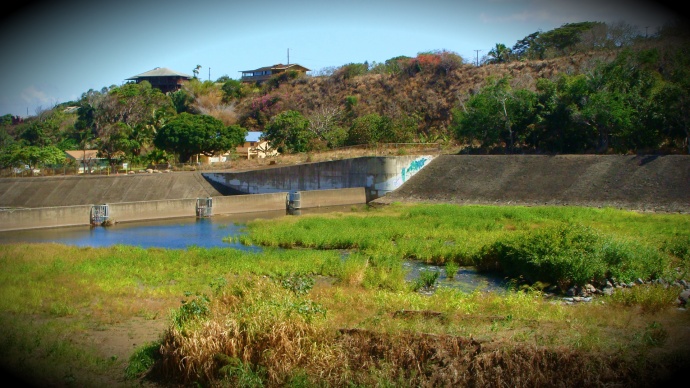
In order for continuous flow downstream, water must get past a diversion near Happy Valley operated by Hawaiian Commercial and Sugar Company. File photo by Wendy Osher.
By Wendy Osher
With the planned historic release of mauka to makai stream flow at ʻĪao planned on Monday, the state Commission on Water Resource Management is seeking assurances that compliance is clear and that the agreement is carried out by parties involved in the contested case.
On Monday, 10 mgd of water will be released near Kepaniwai in ʻĪao Valley; but the decision does not end there. The agreement also calls for at least 5 mgd to flow at or near the Wailuku (ʻĪao) stream mouth.
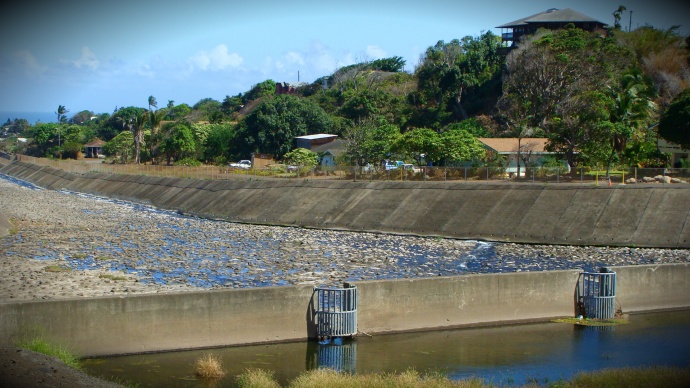
In order for continuous flow downstream, water must get past a diversion near Happy Valley operated by Hawaiian Commercial and Sugar Company. File photo by Wendy Osher.
That means, in order for continuous flow downstream, water must get past a diversion near Happy Valley operated by Hawaiian Commercial and Sugar Company.
In a letter dated Monday, Oct. 6, 2014, the commission requested the assistance of HC&S in fulfilling instream flow standards by releasing water past the company’s Spreckels Ditch.
The company also was given 30 days from the date of the letter to provide a detailed description of their plan to restore biological connectivity across the ditch diversion and ensure continuous flow of water downstream as outlined in the agreement.
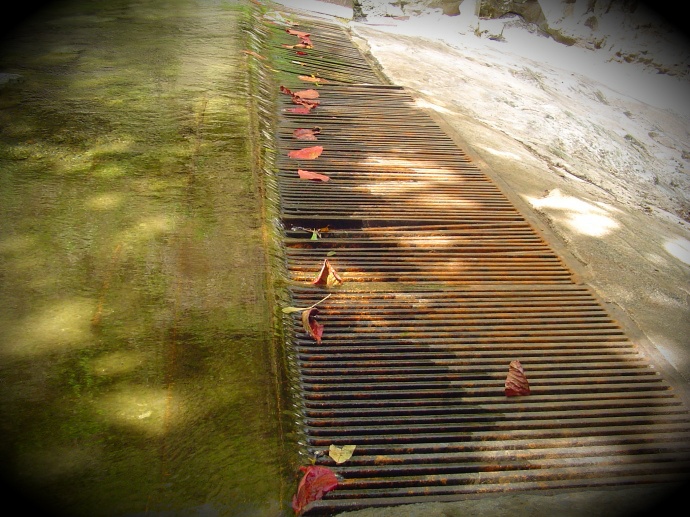
This grate above the Kepaniwai Heritage Park at Wailuku (ʻĪao) Stream is a source of contention as the Commission on Water Resource Management monitors the current use of old sugar company diversions. File photo by Wendy Osher © 2009.
Another area of interest is the Wailuku Water Company intake above the Hawaiʻi Nature Center, which is located mauka of Monday’s planned Kepaniwai water release.
This particular diversion has served as a visual reference during the ongoing debate because of the lack of stream connectivity at the location and the documented dry conditions below the diversion. If mauka to makai flows are to be achieved, this location appears to be a critical factor in achieving that goal.
According to an interim instream flow standard plan filed by the company after the April 2014 ruling, physical construction of a weir was expected to take six weeks to complete. The weir would be used to measure flows returned to the stream, while a gravel trap gate valve would be used to adjust flows back into the stream.
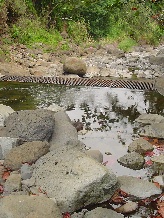
Wailuku (ʻĪao) Stream where diversions and water rights have been the subject of Water Commission reviews. File photo by Wendy Osher.
To facilitate the upstream and downstream passage of native stream life, the company had planned to use the existing structure of two, 2 inch aluminum beams passing water across the intake structure, and the addition of another beam if additional flow was deemed necessary.
Those involved in the contested case considered the beam proposal to be unsatisfactory saying it did not allow enough water to flow over the diversion or allow native species to migrate mauka. Hui o Nā Wai ʻEhā requested for a large “permanent plate” to seal a portion of the diversion to ensure stream connectivity instead, but as of this week, none had been installed.
Under the current structure, the control of water and monitoring at both ʻĪao and Waikapū continues to rest with the Wailuku Water Company.
Wailuku Water Company president Avery Chumbley commented in the joint announcement released by the state Department of Land and Natural Resources on Monday saying, “Wailuku Water Company supports the instream flow standards for the Nā Wai ‘Ehā Streams agreed to by the parties and adopted by the Commission. These standards are flexible enough to address the variability in stream flows that naturally exist. We look forward to working with the Commission to make this a success story.”
In an open letter published by Hui o Nā Wai ʻEhā, the group called the upcoming restoration a “first step in a process that is still very flawed.”
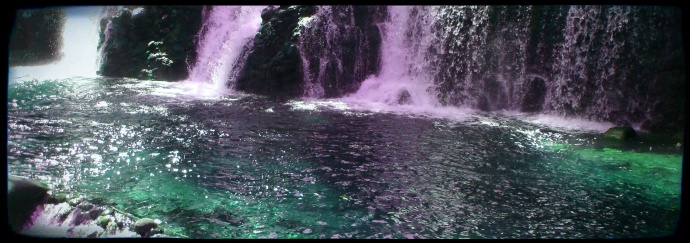
Wailuku (ʻĪao) Stream is a source of contention as the Commission on Water Resource Management monitors the current use of old sugar company diversions. File photo by Wendy Osher.
The organization stated, many more details regarding the water restoration implementation “still need to be worked out,” however the group stated, “we will move forward while ensuring that Wailuku Water Company, HC&S, and the Commission on Water Resource Management follow through and that the laws and the agreed upon decision are upheld.”
The complete text of the letter from Hui o Nā Wai ʻEhā is posted below:
“After 10 years and 4 months (June 2004) which included a long drawn out contested case, protests, marches, documentaries, a dissenting opinion, appeals, and a Supreme Court ruling, Hui o Nā Wai ʻEhā along with Maui Tomorrow and Office Hawaiian Affairs and Earth Justice have secured the release of stream flow from Wailuku Water Company and Hawaiian Commercial & Sugar Company diversions that have been used for 152 years.
For the first time in more than a century, 3 of 4 streams – Wailuku, Waiehu, Waiheʻe – will flow mauka to makai. Waikapū Stream will also have a restored flow, however Wailuku Water Company will continue to divert all of the water near the Honoapiʻilani Highway via the Waiheʻe Intake for use by their paid customers. Waikapū will only flow to the wetlands and estuary of Keālia during sporadic and seasonal freshets.
Monday, October 13, 2014 will be a historic day for streams of Wailuku and Waikapū which will see a restored flow and begin to benefit like the previously restored streams of Waiheʻe and Waiehu in 2010. It is our continued hope to see that;
- Native aquatic species such as ʻoʻopu, ʻōpae, hīhīwai, and hapawai will thrive once again in their natural habitat.
- Farmers will return to their ʻāina to cultivate their loʻi kalo and other crops to further increase Hawaiʻi’s local food sources.
- Aquifers begin to recharge to ensure the longevity of this important resource that affects everyone here on Maui.
- Near shore fisheries and marine habitat will flourish due to replenished estuaries.
- The public will be able to enjoy all parts of the stream whether it be at the muliwai, kumuwai and everyplace in between.
- Ahupuaʻa and communities will be inspired to manage all aspects of their watersheds using best practices.
We would like to mahalo each and everyone of you for continuing to support an issue that affects all of us here on Maui and beyond. Please know that this is just the first step in a process that is still very flawed.
Many more details regarding the Nā Wai ʻEhā implementation still need to be worked out, however, we will move forward while ensuring that Wailuku Water Company, HC&S, and the Commission on Water Resource Management follow through and that the laws and the agreed upon decision are upheld.
It is critical that those who manage this precious resource are held accountable for upholding the Public Trust (Water). We live on islands in the middle of the Pacific Ocean and wai needs to be protected in perpetuity.
This is definitely a time to celebrate and honor those who have waited patiently for years and/or generations for this to occur, many who are no longer with us today. We hope all of you can join us on Monday in ʻĪao to celebrate this historic first step to bringing life back to Nā Wai ʻEhā. E ola ka wai a Kāne.
ʻAʻohe wai…..ʻaʻohe ola. Without water, there is no life.
Mahalo Mahalo Mahalo
Hui o Nā Wai ʻEhā”










